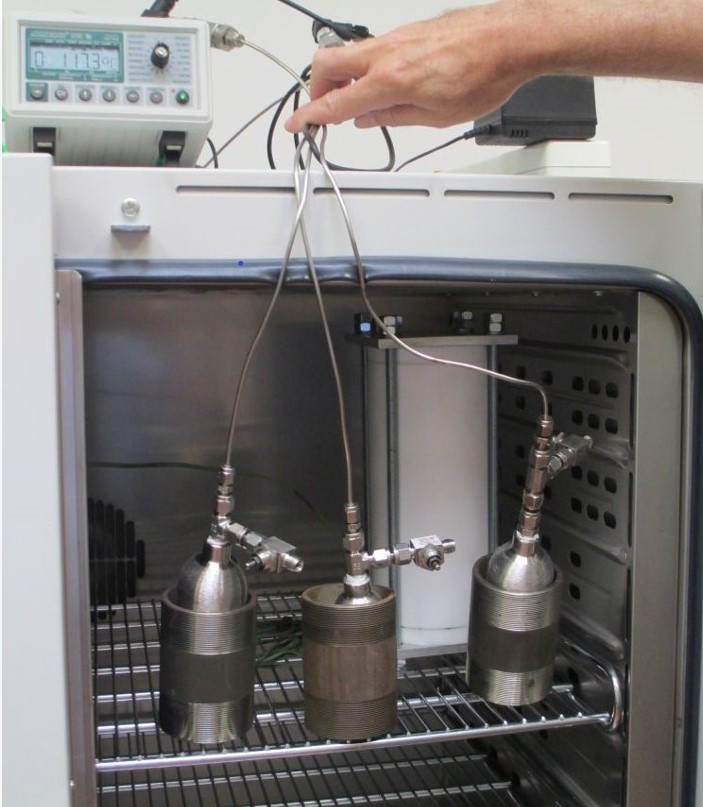Repository Research: Studies on the Effects of Heat on Claystone

Claystone, salt rock or granite are considered suitable host rocks for a radioactive waste repository in Germany. In a current project carried out in the GRS Geoscientific Laboratory, researchers investigate how the properties of claystone formations might be influenced by the waste emplaced.
High-level radioactive waste generates heat. This is due to the decay of radioactive nuclei and nuclear physics processes in which the energy released by decay is converted into heat. In a repository, this decay heat is transferred from the storage casks to the surrounding claystone, which also heats up over time. The maximum temperature will be reached about 1,000 years after emplacement. According to the current requirements of the Repository Site Selection Act, a temperature of 100 degrees Celsius shall not be exceeded on the waste storage cask surface. The legislator has set this limit as a precautionary measure until further research results are available.
In one of their current research projects, scientists of GRS's Repository Research Centre are currently investigating how claystone is influenced by the heat generation in a repository. In a research project financed by the Bundesgesellschaft für Endlagerung (BGE), which is the federally-owned company for radioactive waste disposal, the scientists are approaching the topic both through laboratory experiments and numerical simulations.
Why claystone is a suitable host rock for a radioactive waste repository
Claystone is one of the choices as host rock for a repository for various reasons. It is characterised by the fact that radionuclides adhere to it. Experts refer to this as sorption, which is due to the electrically charged surfaces of the clay minerals. Clay also has a very low permeability. Not least because of these properties, countries such as Switzerland or France are planning to construct repositories for high-level radioactive waste in claystone. According to studies carried out by the German Federal Institute for Geosciences and Natural Resources (BGR), potentially suitable clay rock formations also exist in northern and southern Germany.
Concepts for generic repository sites in argillaceous (clay) rock envisage the storage of the waste at a depth of about 700 to 800 metres. According to these concepts, the storage casks holding the radioactive waste could be emplaced in drifts or in boreholes in a layer of claystone with a thickness of about 110 to 130 metres (southern Germany) or 500 to 600 metres (northern Germany). Current concepts include filling the space around and between the storage casks and walls and ceiling of the drift with bentonite. Bentonite is a special type of claystone with a particularly high proportion of absorbing and swelling minerals.
Step 1: Reproducing relevant processes in the repository by way of laboratory experiments
The experts already know a great deal about the processes in claystone from previous research projects. For example, the heat generated by the waste triggers various developments: Among other things, the clay expands strongly, which reduces both the pores in the claystone and the flow of liquids. At the same time, the pressure in the rock formation increases. In technical language, all these processes, which influence each other, are called "thermal-hydraulic-mechanical-chemical processes" – in short: THMC processes.
In the current project, the scientists now aim to determine even more precisely how the claystone behaves at different temperatures in a range between 25 and 200 degrees. They are investigating both the claystone and the bentonite used for sealing. The goal is to find out whether the changes in the clay rock impact the so-called integrity of the host rock, e. g. by altering its sealing and containing properties. A loss of integrity could occur, for example, if the containers became leaky after a few thousand to ten thousand years and, due to excess pressure, a path were formed in the claystone through which radioactive substances could enter the overlying water-bearing rock strata.
To this end, the researchers are investigating the coupled thermal-hydraulic-mechanical processes by measuring in special containers in the laboratory how permeability and pressure change due to the swelling of the clay at rising temperatures. They produce the equipment they need to do so themselves in a 3D printer or have it custom-made especially for a single experiment.
Step 2: Recalculate experiments with simulation codes
While investigations in the laboratory can only be carried out selectively, simulation allows an insight into all possible states (e.g. at different temperatures and at different times). Therefore, the researchers use the results from the aforementioned experiments to further develop respective simulation codes.
The project uses the open source code Phreeq. For geochemical model calculations, they refer to data orvided by the thermodynamic reference database THEREDA. THEREDA is being jointly developed and maintained by different research institutions and also financed by the Bundesgesellschaft für Endlagerung (BGE).
The research project will run until mid-2021. The results will be published and made available i. a. on the publication database of GRS.
Find out more
GRS Repository Research: from radionuclide to repository concept
THEREDA: Thermodynamic reference database
GRS studies on the temperature on the outer surface of disposal casks
GRS develops safety case concept for a repository in argillite
Sven Dokter
GRS gGmbH
sven.dokter@grs.de